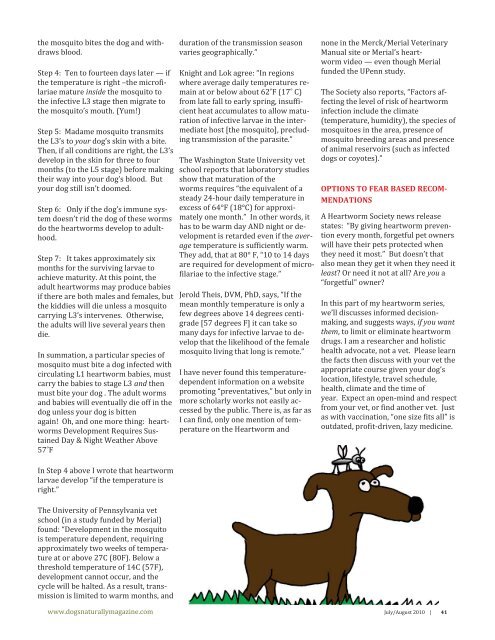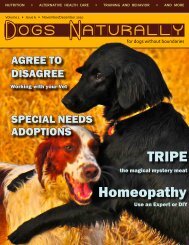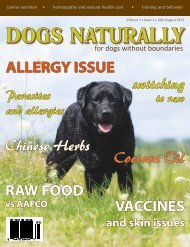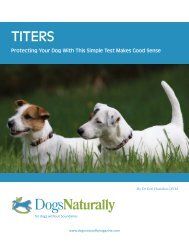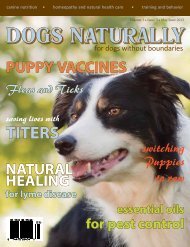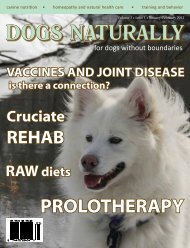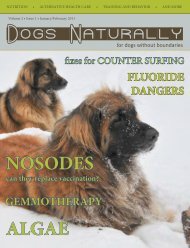July/August 2010 - Dogs Naturally Magazine
July/August 2010 - Dogs Naturally Magazine
July/August 2010 - Dogs Naturally Magazine
You also want an ePaper? Increase the reach of your titles
YUMPU automatically turns print PDFs into web optimized ePapers that Google loves.
the mosquito bites the dog and withdraws<br />
blood.<br />
Step 4: Ten to fourteen days later — if<br />
the temperature is right –the microfilariae<br />
mature inside the mosquito to<br />
the infective L3 stage then migrate to<br />
the mosquito’s mouth. (Yum!)<br />
Step 5: Madame mosquito transmits<br />
the L3’s to your dog’s skin with a bite.<br />
Then, if all conditions are right, the L3’s<br />
develop in the skin for three to four<br />
months (to the L5 stage) before making<br />
their way into your dog’s blood. But<br />
your dog still isn’t doomed.<br />
Step 6: Only if the dog’s immune system<br />
doesn’t rid the dog of these worms<br />
do the heartworms develop to adulthood.<br />
Step 7: It takes approximately six<br />
months for the surviving larvae to<br />
achieve maturity. At this point, the<br />
adult heartworms may produce babies<br />
if there are both males and females, but<br />
the kiddies will die unless a mosquito<br />
carrying L3’s intervenes. Otherwise,<br />
the adults will live several years then<br />
die.<br />
In summation, a particular species of<br />
mosquito must bite a dog infected with<br />
circulating L1 heartworm babies, must<br />
carry the babies to stage L3 and then<br />
must bite your dog . The adult worms<br />
and babies will eventually die off in the<br />
dog unless your dog is bitten<br />
again! Oh, and one more thing: heartworms<br />
Development Requires Sustained<br />
Day & Night Weather Above<br />
57˚F<br />
In Step 4 above I wrote that heartworm<br />
larvae develop “if the temperature is<br />
right.”<br />
The University of Pennsylvania vet<br />
school (in a study funded by Merial)<br />
found: “Development in the mosquito<br />
is temperature dependent, requiring<br />
approximately two weeks of temperature<br />
at or above 27C (80F). Below a<br />
threshold temperature of 14C (57F),<br />
development cannot occur, and the<br />
cycle will be halted. As a result, transmission<br />
is limited to warm months, and<br />
duration of the transmission season<br />
varies geographically.”<br />
Knight and Lok agree: “In regions<br />
where average daily temperatures remain<br />
at or below about 62˚F (17˚ C)<br />
from late fall to early spring, insufficient<br />
heat accumulates to allow maturation<br />
of infective larvae in the intermediate<br />
host [the mosquito], precluding<br />
transmission of the parasite.”<br />
The Washington State University vet<br />
school reports that laboratory studies<br />
show that maturation of the<br />
worms requires “the equivalent of a<br />
steady 24-hour daily temperature in<br />
excess of 64°F (18°C) for approximately<br />
one month.” In other words, it<br />
has to be warm day AND night or development<br />
is retarded even if the average<br />
temperature is sufficiently warm.<br />
They add, that at 80° F, “10 to 14 days<br />
are required for development of microfilariae<br />
to the infective stage.”<br />
Jerold Theis, DVM, PhD, says, “If the<br />
mean monthly temperature is only a<br />
few degrees above 14 degrees centigrade<br />
[57 degrees F] it can take so<br />
many days for infective larvae to develop<br />
that the likelihood of the female<br />
mosquito living that long is remote.”<br />
I have never found this temperaturedependent<br />
information on a website<br />
promoting “preventatives,” but only in<br />
more scholarly works not easily accessed<br />
by the public. There is, as far as<br />
I can find, only one mention of temperature<br />
on the Heartworm and<br />
none in the Merck/Merial Veterinary<br />
Manual site or Merial’s heartworm<br />
video — even though Merial<br />
funded the UPenn study.<br />
The Society also reports, “Factors affecting<br />
the level of risk of heartworm<br />
infection include the climate<br />
(temperature, humidity), the species of<br />
mosquitoes in the area, presence of<br />
mosquito breeding areas and presence<br />
of animal reservoirs (such as infected<br />
dogs or coyotes).”<br />
OPTIONS TO FEAR BASED RECOM-<br />
MENDATIONS<br />
A Heartworm Society news release<br />
states: “By giving heartworm prevention<br />
every month, forgetful pet owners<br />
will have their pets protected when<br />
they need it most.” But doesn’t that<br />
also mean they get it when they need it<br />
least? Or need it not at all? Are you a<br />
“forgetful” owner?<br />
In this part of my heartworm series,<br />
we’ll discusses informed decisionmaking,<br />
and suggests ways, if you want<br />
them, to limit or eliminate heartworm<br />
drugs. I am a researcher and holistic<br />
health advocate, not a vet. Please learn<br />
the facts then discuss with your vet the<br />
appropriate course given your dog’s<br />
location, lifestyle, travel schedule,<br />
health, climate and the time of<br />
year. Expect an open-mind and respect<br />
from your vet, or find another vet. Just<br />
as with vaccination, “one size fits all” is<br />
outdated, profit-driven, lazy medicine.<br />
www.dogsnaturallymagazine.com <strong>July</strong>/<strong>August</strong> <strong>2010</strong> | 41


